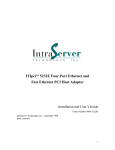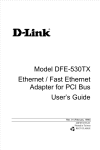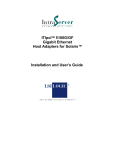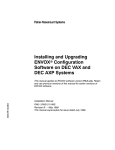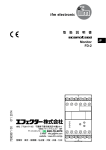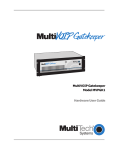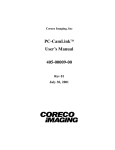Download Compaq Ultra SCSI Adapter User`s guide
Transcript
Compaq Ultra SCSI Adapter For OpenVMS™ VAX™ Installation and User’s Guide Part Number: EK-KZMCA-IN. V01 Compaq Ultra SCSI Adapter For OpenVMS™ VAX™ Installation and User’s Guide Part Number: EK-KZMCA-IN. V01 July 21, 1999 Revision/Update Information: This is a new manual. Compaq Computer Corporation Maynard, Massachusetts 2 Copyright 1999 First Printing, December 1999 The information in this document is subject to change without notice and should not be construed as a commitment by Compaq Computer, Inc. Compaq Computer, Inc. assumes no responsibility for any errors that may appear in this document. The software, if any, described in this document is furnished under a license and may be used or copied only in accordance with the terms of such license. No responsibility is assumed for the use or reliability of software or equipment that is not supplied by Compaq Computer, Inc. or its affiliated companies. Copyright Compaq Computer, Inc., 1999. All Rights Reserved. The Reader’s Comments form at the end of this document requests your critical evaluation to assist in preparing future documentation. The following are trademarks of IntraServer Technology, Inc.: ITIpci TM, ClusterReady, IntraServer, and the IntraServer logo. OpenVMS™ and VAX™ are trademarks of Digital Equipment or Compaq Computer Corporation, all other trademarks and registered trademarks are the property of their respective holders. 3 FCC NOTICE: Warning! This is a Class A product. In a domestic environment this product may cause radio interference in which case the user may be required to take adequate measures. Achtung! Dieses ist ein Gerät der Funkstörgrenzwertklasse A. In Wohnbereichen können bei Betrieb dieses Gerätes Rundfunkstörungen auftreten, in welchen Fällen der Benutzer für entsprechende Gegenmaßnahmen verantwortlich ist. Attention! Ceci est un produit de Classe A. Dans un environnement domestique, ce produit risque de créer des interférences radioélectriques, il appartiendra alors à l'utilisateur de prendre les mesures spécifiques appropriées. This equipment generates, uses, and may emit radio frequency energy. The equipment has been type tested and found to comply with the limits for a Class A digital device pursuant to Part 15 of FCC rules, which are designed to provide reasonable protection against such radio frequency interference. Operation of this equipment in a residential area may cause interference in which case the user at his own expense will be required to take whatever measures may be required to correct the interference. Any modifications to this device - unless expressly approved by the manufacturer can void the user’s authority to operate this equipment under part 15 of the FCC rules. 4 FCC Declaration of Conformity The IntraServer Technology, Inc. ITIpci Ultra SCSI adapter, model numbers 5xxx comply with the requirements of FCC part 15, class A as defined under paragraph 2.909 of these rules. This declaration covers products identified with ITI 5140U-V1, ITI 5140UV2, ITI 5140U-V3, ITI 5140U-V4 and ITI 5140U-V5 on the product label. A copy of the test report substantiating compliance is available on request from: Corporate EMC Manager IntraServer Technology, Inc. Seven October Hill Road Holliston, MA 01746 5 Table of Contents Introduction __________________________________ 9 VAX™-SCSI Hardware Covered by This Guide ______ 9 Software Covered by This Guide ___________________ 9 Documentation Organization _____________________ 10 Adapter Specification__________________________ 11 Overview ______________________________________ 11 Required Software ______________________________ 11 Required VMS Patches ______________________________ 12 Restrictions ____________________________________ 13 Performance ___________________________________ 13 Adapter Installation ___________________________ 14 Termination ___________________________________ 14 Installing the VAX-SCSI Host Adapter_____________ 15 Preparing your System _______________________________ 15 DS-KZCCA-AB Installation Procedure__________________ 16 Removing System Cover ___________________________ 16 Option Locations VAX4000™ and MicroVAX3100™ ___ 17 DS-KZCCA-AB Configuration Restrictions ______________ 17 DS-KZCCA-AB Installation Procedure__________________ 18 Installing the VAX™-SCSI adapter___________________ 18 Routing the Internal Cables _________________________ 19 I/O bulkhead installed _____________________________ 20 DS-KZCCA-BB Installation Procedure __________________ 21 Removing the VAXStation System Cover______________ 21 Option Locations VAXStation™ _____________________ 22 Configuration Restrictions __________________________ 22 DS-KZCCA-BB VAX-SCSI Installation procedure ________ 22 Installing the DS-KZCCA-BB VAX™-SCSI adapter _____ 23 Attaching the I/O bulkhead and internal SCSI Cable______ 24 DS-KZCCA-CB Installation Procedure __________________ 25 Removing System Cover ___________________________ 25 Removing the CPU Access Cover ____________________ 26 6 Configuration Restrictions __________________________ 27 Compaq VAX™-SCSI Installation Procedure_____________ 27 Cable Routing Example ____________________________ 28 Installing the DS-KZCCA-CB adapter ________________ 29 DS-KZCCA-DB Installation Procedure__________________ 30 Removing System Cover ___________________________ 30 Removing Enclosure Access Cover ___________________ 30 Option Locations _________________________________ 31 Compaq VAX™-SCSI Installation Procedure___________ 31 Installing the DS-KZCCA-DB adapter ________________ 32 Configuring the SCSI Bus______________________ 33 Termination ___________________________________ 33 SCSI IDs ______________________________________ 33 Cabling SCSI Devices ___________________________ 34 Connecting External SCSI Devices _____________________ 35 Device Drivers for OpenVMS™ _________________ 36 IntraServer’s Digital OpenVMS™-VAX™ driver features: ______________________________________ 36 Installation ________________________________________ 37 Existing System Installation_________________________ 37 VMSINSTAL.COM Installation Example______________ 38 Testing Your Installation ___________________________ 41 Appendix A: Specifications _____________________ 43 Mechanical Specifications (DS-KZCCA-AB) ________ 43 Physical Dimensions:________________________________ 43 Connector and Jumper Configuration Drawing: _________ 43 Mechanical Specifications (DS-KZCCA-BB) _____________ 43 Physical Dimensions:______________________________ 43 Connector and Jumper Configuration Drawing: _________ 44 Mechanical Specifications (DS-KZCCA-CB) _____________ 44 Physical Dimensions:______________________________ 44 Connector and Jumper Configuration Drawing: _________ 44 SCSI and Ethernet Connections________________________ 44 Electrical Requirements ______________________________ 45 Power Requirements (Typical): ______________________ 45 Environmental _____________________________________ 45 Temperature Range (Operating): _____________________ 45 Relative Humidity Range (Operating): ________________ 45 7 Altitude: ________________________________________ 45 Mechanical (Operating): ___________________________ 45 Mechanical (Non-Operating) (Transport/Storage): _______ 46 Flammability: ____________________________________ 46 Functional Requirements/Features: ___________________ 46 Software: _______________________________________ 46 Reliability: ______________________________________ 46 Federal Communications Commission and international Agencies: _______________________________________ 47 PACKAGING AND SHIPPING:_______________________ 47 Glossary of Terms ____________________________ 48 List of Figures__________________________________ 49 List of Tables __________________________________ 49 8 Introduction Compaq’s VAX™-SCSI™ Ultra SCSI host adapters for the Digital/Compaq’s VAX™ system platform bring state of the art SCSI performance and connectivity to the VAX™ system line. Compaq’s VAX™-SCSI adapters allow direct connection of Wide (16 bit) differential UltraSCSI disks, tapes and RAID controllers, increasing overall system performance and storage capacity. This manual will serve as a step by step guide during the installation of your VAX-SCSI host adapter in your computer. VAX™-SCSI Hardware Covered by This Guide This guide covers the installation and operation of Compaq’s complete line of VAX™-SCSI Ultra SCSI adapters as follows: DS-KZCCA-AB Ultra Wide SCSI Differential Adapter for: VAX™ 4000-100, -100A, -105A, -106A MicroVAX™ 3100-85, -90, -95, -96 DS-KZCCA-BB Ultra Wide SCSI Differential Adapter for: VAXstation™ 4000-90, -90A, -96 DS-KZCCA-CB Ultra Wide SCSI Differential Adapter for: VAX™ 4000-700A, -705A VAX™ 4000-600A VAX™ 4000-500A, -505A DS-KZCCA-DB Ultra Wide SCSI Differential Adapter for: VAX™ 4000-108, MicroVAX™ 3100-88, MicroVAX™ 3100-98 DS-KZMCA-AB* Ultra Wide SCSI Differential Adapter for : XMI based systems *Note: Not available at this time Software Covered by This Guide Compaq’s VAX™-SCSI adapters are supported under OpenVMS™-VAX™ beginning with version V5.5-2H4. Software updates and information can be found at http://www.IntraServer.com. 9 Documentation Organization This manual is organized into the following sections: Adapter Specification Adapter Configuration BIOS and Firmware Configuration Software Drivers Configuration Utilities 10 Adapter Specification Overview The Compaq VAX™-SCSI Wide Ultra SCSI Host is based on the LSI 53C875 SCSI controller chip. This chip includes the following: • Onboard RISC processor • Internal 512Byte FIFO • Internal 4Kbyte Script RAM • One interrupt per I/O scripts IntraServer’s SCSI script implementation on the Symbios (LSI Logic) 53C875 SCSI processor offloads the CPU to deliver higher efficiency and lower CPU utlization. All low level SCSI functions are completed by SCRIPTS, which only interrupt the host when an I/O is complete. This allows the SCSI interface to perform at a higher I/O rate than previous implementations, which were limited by the processor’s ability to service frequent interrupts. Adapters designed for systems with a CDAL bus (Compaq adapters versions DS-KZCCA-AB, -BB, -CB and -DB) interface directly to the CPU on the CDAL bus, allowing for maximum I/O bandwidth possible for these systems. Compaq’s DS-KZMCA-AB adapter (currently under development) implements the XMI interface, and is intended to be used in XMI based systems. The high performance PCI SCSI core is interfaced to the system bus (CDAL or XMI) by use of a Field Programmable Gate Array. The FPGA provides arbitration for the PCI devices (SCSI and Ethernet are available options), interrupt controll and data path. Required Software IntraServer’s PKW driver, a high performance Wide Ultra SCSI driver is used as the port driver for the VAX-SCSI implementation. PKW is a port of IntraServer’s PKWDRIVER which has been fully qualified by digital, and is now part of the OpenVMS/Alpha distribution (V7.1-2 and V7.2). PKW interfaces with the high performance scripts on the 53C875 to maximize SCSI data throughput while minimizing CPU overhead. 11 IntraServer has implemented a port naming convention for SCSI devices on PKWdriver to maximize the number of SCSI devices that can be used in a cluster without being limited by the SCSI naming convention implemented by OpenVMS. The driver can optionally be set to name the SCSI ports PKW (default), PKX, PKY, or PKZ. This is done so that in cluster applications the SCSI devices on one host system will not conflict with the SCSI devices on another system with the same allocation class. The installation procedure will inquire about the port letter required. Required VMS Patches Your VMS system must have all SCSI patches for the version you are running. These patches are available from Compaq on the internet. If your system is not up to date, you may experience SCSI device problems. Check for the latest patch information for your version of VMS at the following There are some required VMS patches required to certain versions of VMS required to run the Compaq VAX-SCSI option. These are found on the support web site at: http://ftp.service.digital.com/patches/public/vms/vax/ You must have all SCSI related patches for your version of VMS, for example: http://ftp.service.digital.com/patches/public/vms/vax/v6.2/vaxscsi01_062.README If you are shadowing, you must also have all shadowing related patches, for example: http://ftp.service.digital.com/patches/public/vms/vax/v6.2/vaxshad08_062.README Install all patches before you install the IntraServer driver kit. 12 Restrictions The following restrictions apply when using the VAX SCSI option in certain systems. Please adhere to the restrictions below in order to ensure correct operation: Model Restriction 5140-V1 Takes up DSH42 (async option) Slot Cannot be used with the KZQSA 5140-V2 Takes up Turbo-channel adapter slot 5140-V3 Cannot be used with KZQSA 5140-V4 Takes up DSH42 (Async option) Slot Cannot be used with the KZQSA 5140-V5 TBD Performance Compaq’s VAX SCSI adapters bring state of the art Ultra SCSI disks and tapes to the VAX architecture, and significantly increase the I/O throughput available. For single block, sequential I/O (512 bytes) the Compaq adapters are capable of doing 5000 I/Os per second, running OpenVMS to Ultra SCSI disks. Large I/O throughput is limited more by the CDAL architecture than by SCSI. Sequential I/Os of 127 blocks (65024 bytes) achive 10.3Mbytes/sec. For comparison, large sequential reads over DSSI achive 3.3MBytes/sec, and the native narrow SCSI (onboard) achives 3.0Mbytes/sec in equivalent tests. 13 Adapter Installation Termination Compaq VAX™-SCSI Ultra SCSI Host adapters include on-board Differential SCSI drivers and termination. The Comapq adapter is always at the end of the SCSI chain, and therefore always must terminate the SCSI bus. An external SCSI Connector and cabling is provided for connection to external SCSI devices. Correct installation of your adapter requires that you first understand the basic rules of the SCSI bus and correctly configure the termination based on the position of the external devices on the bus. In order for a SCSI bus to operate, it must be electrically terminated at both ends. Your VAX™-SCSI adapter is at the end of the SCSI bus and will always have termination enabled. You must place a Differential SCSI terminator at the LAST device on the SCSI chain. No other devices on the bus should provide termination. 14 Installing the VAX-SCSI Host Adapter Preparing your System The instructions in this section must be followed regardless of your system type. Once you have completed these general procedures, skip to the section below that best describes your system type and configuration. Before you begin installing your Compaq VAX™-SCSI UltraSCSI adapter, you must follow the steps below: 1. Back up your files Follow the instructions in your software documentation to do a complete backup of your system and user disks. It is important that you have a complete backup set, and can restore your system completely, to prevent possible data loss. 2. Shut down the system Use your site specific shutdown procedure to shut down your running system. 3. Turn off the system 4. Unplug the system from the AC power, and unplug all external cables from the system enclosure, taking note on where all connections were, so that they can be re-connected when the installation is complete. 15 DS-KZCCA-AB Installation Procedure Use this installation procedure if your system type is VAX4000™-100, 100A, -105A, -106A, or MicroVAX3100™-85, -90, -95 or -96. Removing System Cover After the system has been shut down, and power has been removed from the system, remove the system cover or access panel to gain access to the processor module. Access to the enclosure differs based on your system type, basic configuration examples are given here. Consult your system documentation for more information regarding accessing the system internals. Figure 1: Removing the system cover Note: To avoid damage from static discharge, as soon as you remove the cover, and before touching anything inside the system unit, touch the TOUCH ME FIRST label, or a metal part on the top of the power supply. It is recommended that you wear an antistatic wrist strap and use and antistatic mat when adding options inside the system unit. 16 Option Locations VAX4000™ and MicroVAX3100™ 2 1 3 4 1. Power Supply 2. Memory Modules 3. Communications devices (synchronous communications slot, asynchronous option slot) 4. Disk drive mounting hardware (remove from enclosure to expose CPU module) Figure 2: VAX4000 and MicroVAX3100 Option Locations Locate the options listed above within your system enclosure. You may need to temporarily remove one or more options in order to install your Compaq VAX™-SCSI option. DS-KZCCA-AB Configuration Restrictions You can not have the Compaq VAX™-SCSI option in your system at the same time as the asynchronous communications option. If this option is in your system, it must be removed if you want to run the Compaq adapter. 17 DS-KZCCA-AB Installation Procedure The table below provides an overview of the VAX™-SCSI installation procedure. The remainder of this section explains each step in more detail. 1. Touch the TOUCH HERE space or a metal piece on the top of the power supply 2. Remove the I/O filler plate 3. Remove the asynchronous communication adapter (if present) 4. Install the internal SCSI cable on the VAX™-SCSI module 5. Install the VAX™-SCSI module in your system, by aligning the connector on the back of the module with the receptacle on the CPU board. When you are certain the connectors are aligned, gently apply pressure directly above the connector until the connectors seat. Last, clip the module to the retaining clips. Installing the VAX™-SCSI adapter Figure 3 Installing the VAX-SCSI module 6. Re-attach any SCSI cables which were removed 18 7. Attach the I/O bulkhead to the cutout at the rear of the system, with the screws provided. Be careful to route the cable in a way that will not interfere with other system components or the system cover. Routing the Internal Cables Figure 4: Routing the internal cables. 19 I/O bulkhead installed Figure 5: I/O Bulkhead installed 8. Replace the system cover, and all external cables. 20 DS-KZCCA-BB Installation Procedure Use this installation procedure if your system type is a Vaxstation 4000-90, 90A, or –96. Removing the VAXStation System Cover After the system has been shut down, and power has been removed from the system, remove the system cover or access panel to gain access to the processor module. Access to the enclosure differs based on your system type, basic configuration examples are given here. Consult your system documentation for more information regarding accessing the system internals. Figure 6: Accessing the VAXStation CPU Note: To avoid damage from static discharge, as soon as you remove the cover, and before touching anything inside the system unit, touch the TOUCH ME FIRST label on the top of the power supply. It is recommended that you wear an antistatic wrist strap and use and antistatic mat when adding options inside the system unit. 21 Option Locations VAXStation™ 3 1 2 4 1. Power Supply 2. Memory Modules 3. Graphics Module 4. Internal Storage Figure 7: Vaxstation Option Locations Locate the options listed above within your system enclosure. You may need to temporarily remove one or more options in order to install your Compaq VAX™-SCSI option. Configuration Restrictions You can not have the Compaq VAX SCSI option in your system at the same time as the TURBO channel adapter. If this adapter is in your system, it must be removed if you want to run the Compaq adapter. DS-KZCCA-BB VAX-SCSI Installation procedure The table and figures below detail the steps required to install the VAX-SCSI adapter in your VAXStation system. If additional information is required, please consult your system documentation. 22 1. Touch the TOUCH HERE space on the power supply 2. Disconnect the SCSI cable from the system board and from the opening over the TURBOchannel port. 3. Remove the filler plate 4. Temporarily remove the graphics board (if applicable) 5. Remove the TURBOchannel adapter if one is present. This adapter can NOT co-exist with the Compaq VAX™-SCSI adapter. 6. Install the internal SCSI cable on the VAX™-SCSI module 7. Install the VAX™-SCSI module in your system, by aligning the connector on the side of the module with the receptacle on the CPU board. When you are certain the connectors are aligned, gently apply pressure directly above the connector until the connectors seat. Last, clip the module to the retaining clips. Installing the DS-KZCCA-BB VAX™-SCSI adapter Figure 8: Installing the DS-KZCCA-BB VAX™-SCSI Adapter 23 8. Replace the graphics board if one was removed 9. Re-attach any SCSI cables which were removed 10. Attach the I/O bulkhead to the cutout at the rear of the system, with the screws provided. Be careful to route the cable in a way that will not interfere with other system components or the system cover. Attaching the I/O bulkhead and internal SCSI Cable Retaining Screw 68 Pin HVD SCSI Connector Figure 9: DS-KZCCA-BB I/O bulkhead Installed 11. Replace the system cover, and all external cables. 24 DS-KZCCA-CB Installation Procedure Use this installation procedure if your system type is VAX4000-500A, 505A, -600A, -700A or –705A. Removing System Cover After the system has been shut down, and power has been removed from the system, open the lower system door. Using a phillips head screwdriver, release the CPU access cover by turning the retaining screws ¼ of a revolution counter-clockwise. Remove the cables from the CPU module, and carefully remove the access cover by lifting it slightly and gently pulling it toward you. Consult your system documentation for more information regarding accessing the system internals. 25 Removing the CPU Access Cover Figure 10: Accessing the CPU Module Note: To avoid damage from static discharge, before removing the access panel, touch a metal part of the power supply. It is recommended that you wear an antistatic wrist strap and use and antistatic mat when adding options inside the system unit. Locate the CPU module within your system enclosure. You will need to remove the CPU module from the system in order to install your Compaq VAX™-SCSI option. Consult your system documentation for details of this procedure. 26 Configuration Restrictions You can not have the Compaq VAX™-SCSI option in your system at the same time as the KZQSA Q-Bus SCSI adapter. If this module is in your system, it must be removed if you want to run the VAX-SCSI adapter. Compaq VAX™-SCSI Installation Procedure The table below provides an overview of the VAX™-SCSI installation procedure. 1. Touch a metal piece of the system enclosure or power supply 2. Disconnect the SCSI cable from the CPU module 3. Remove the CPU module from the system. 4. Remove an unused I/O bulkhead handle from the system, and replace it with the VAX™-SCSI I/O handle provided with your kit. Route the SCSI cable from the VAX™-SCSI I/O bulkhead from the I/O section of your enclosure to the CPU area. You will need to be sure the cable routing does not interfere with any system options. 27 Cable Routing Example Figure 11 Routing the Cables 5. Install the VAX™-SCSI module in your system, by aligning the connector on the back of the module with the receptacle on the CPU board. When you are certain the connectors are aligned, gently apply pressure directly above the connector until the connectors seat. Last, clip the module to the retaining clips. 28 Installing the DS-KZCCA-CB adapter Figure 12: Installing the DS-KZCCA-CB VAX™-SCSI Adapter 6. Connect the internal SCSI I/O cable you routed from the I/O bulkhead in step 4, above. Replace the CPU module by gently sliding it into the backplane, and operating the retaining levers. Consult your system documentation if any additional information is required. 7. Replace the system cover, and all external cables. 29 DS-KZCCA-DB Installation Procedure Use this installation procedure if your system type is VAX™4000-108, MicroVAX™3100-88 or MicroVAX™-98. Removing System Cover After the system has been shut down, and power has been removed from the system, remove the system cover by releasing the retaining screws. Locate the I/O option slots, and remove one of the blank I/O panels. Consult your system documentation for more information regarding accessing the system internals. Removing Enclosure Access Cover Figure 13: Accessing the I/O slots Note: To avoid damage from static discharge, before removing the system cover, touch a metal part of the enclosure. It is recommended that you wear an antistatic wrist strap and use and antistatic mat when adding options inside the system unit. 30 Option Locations 1 Async Slot 2 3 1. CPU Module 2. Mother Board 3. I/O expansion slots Figure 14: Option Locations Locate the options listed above within your system enclosure. You may need to temporarily remove one or more options in order to install your Compaq VAX™-SCSI option. Compaq VAX™-SCSI Installation Procedure The table below provides an overview of the VAX™-SCSI installation procedure. 1. Touch a metal piece of the system enclosure or power supply 2. Locate an unused I/O Slot 3. Remove an unused I/O bulkhead handle from the system 4. Insert the VAX™-SCSI module into the Async option slot. The slot is closest to the center divider of the enclosure. 31 Note: Refer to the diagram below Installing the DS-KZCCA-DB adapter Figure 15: Installing the DS-KZCCA-DB VAX™-SCSI Adapter 5. Replace the system cover, and all external cables. 32 Configuring the SCSI Bus Some basic SCSI principles must be applied in order to configure the SCSI bus on your system correctly. These are: Termination The SCSI bus must be terminated at both ends, and only at the ends. Configure the termination on your VAX-SCSI adapter using the configuration information in the preceding chapter. Refer to the documentation for each device on the SCSI bus, to ensure: 1. Devices at the ENDS of the bus have TERMINATION ENABLED (or installed) 2. Devices not at the END of the bus have TERMINATION DISABLED (or removed) Note: Most difficulties with the SCSI bus can be traced to improper termination and cabling. Note: Your Compaq VAX™-SCSI card always provides High Voltage Differential Termination (HVD). You must provide HVD termination after the last device on the end of the external cable. SCSI IDs Each device and host adapter on the SCSI bus must have a unique SCSI ID. The host adapter must be left at its default ID of 7. On a 16 bit (WIDE) VAX™-SCSI bus, each device must have a unique SCSI ID from 0 - 7. The Compaq VAX™-SCSI adapter defaults to ID 7. All other devices on the bus should be given IDs from 0 – 6. Refer to the documentation for each of your devices for the method of setting the SCSI ID for that device. NOTE: VAX™-OpenVMS™ does not currently support SCSI IDs above 7. Refer to your specific operating system for details. 33 Cabling SCSI Devices Compaq’s VAX™-SCSI adapters support up to 7 devices per SCSI channel. All devices must be Differential SCSI (HVD), and can include Disks, Tapes and RAID devices. Compaq’s SCSI adapters have been qualified with Compaq’s StorageWorks family of storage devices. Devices must be configured external to the system enclosure. Compaq’s VAX™-SCSI adapter is designed to allow SCSI bus lengths up to 25 Meters. It is highly recommended that a high quality SCSI cable be selected for all device connections, due to the importance of optimal signal integrity, and to ensure compliance with regulatory agency approval for system emissions. Most problems encountered during the initial installation of a SCSI system can be traced to improper or low quality cabling and termination. Compaq carries a complete line of high quality SCSI cables which are compatible with Compaq’s VAX™-SCSI adapters, which can be ordered to meet the requirements of your configuration. 34 Connecting External SCSI Devices Optional cables are available from Compaq for all external devices. See the cable selection table in this guide to determine the correct cable for your application. Apply these rules for IDs and termination: • Only the end device on the bus (last device on the cable) should have termination enabled The VAX™-SCSI adapter ALWAYS provides termination • Each device must have a unique SCSI ID The VAX™-SCSI adapter is ALWAYS at SCSI ID 7 35 Device Drivers for OpenVMS™ IntraServer’s OpenVMS™ driver enables the use of Ultra SCSI Differential disks, tapes and RAID enclosures, such as Compaq’s StorageWorks line of disk enclosures, to maximize the VAX™ system’s I/O throughput and storage capacity. IntraServer’s OpenVMS™ drivers are optimized for minimum load on the system processor(s) by use of a loadable SCRIPT to handle low level SCSI operations and minimize the number of interrupt requests to the system. For the case of small I/Os, IntraServer’s OpenVMS™ driver will only interrupt the host once for each I/O, compared with several interrupts per I/O for other SCSI adapters. IntraServer’s Ultra SCSI OpenVMS™ drivers also feature: IntraServer’s Digital OpenVMS™-VAX™ driver features: • Supports Ultra SCSI at speeds up to 40MBytes/Sec per channel (UltraSCSI peak synchronous rate. Your system will be limited to the system’s bus bandwidth, which can be below this peak rate) • Supports over 5000 single block I/Os per second per channel • Supports synchronous negotiation (including Fast/Ultra SCSI) • Minimum interrupt per I/O script technology for maximum I/O throughput with minimum CPU overhead • Supports up to 7 disks per channel • vmsinstal.com support for simple installation • Supports wide negotiation • Supports tagged command queuing • Supports multiple Logical Unit Numbers (LUNs) • Supports Disconnect/Reselect • Supports differential SCSI • Supports Host Based Shadowing 36 Installation Existing System Installation Before starting, please check the installation floppy, CD-ROM or Tape for a readme.txt file, which may contain any changes or additions to the installation procedure that occurred after the printing of this manual. Information can also be found at IntraServer’s Web Page, at http://www.intraserver.com. Mount the installation media on your system. This procedure will differ depending on weather you are using a CD-ROM, Floppy Disk or Tape. 1. Mount the installation media: $ mount dva0: /over=id $ mount dka500: /over=id $ mount mka400: /over=id Note: 2. (Floppy disk example) (CD-ROM example) (Tape example) Your device names will be different from this example Create a temporary directory to hold the installation files: $ create/dir sys$sysdevice:[vaxscsi] 3. Copy the installation files from your installation media to your temporary installation file: $ copy dva0:[vaxscsi]*.* sys$sysdevice:[vaxscsi] (Floppy) $ copy dka500:[vaxscsi]*.* sys$sysdevice:[vaxscsi] (CD) $ copy mka400:[vaxscsi]*.* sys$sysdevice:[vaxscsi] (Tape) Note: Your device names will be different from this example Note: If you received the kit as a .zip file, unzip it into this temporary directory. Unzip-vax.exe can be obtained from IntraServer’s web site at http://www.intraserver.com/download/vax/unzip-vax.exe Set default to your system’s software update area: $ set def sys$update 4. Invoke the vmsinstall command procedure to install the drivers: $ @vmsinstal 37 VMSINSTAL.COM Installation Example The following installation session is provided as an example. Your session may differ based you’re your system configuration. Before starting, you must have a complete current backup of your system disk. LAB9-> @vmsinstal OpenVMS AXP Software Product Installation Procedure It is 15-MAR-1999 at 16:53. Enter a question mark (?) at any time for help. * Are you satisfied with the backup of your system disk [YES]? * Where will the distribution volumes be mounted: sys$sysdevice:[VAXSCSI] Enter the products to be processed from the next distribution volume set. * Products: * The following products will be processed: VAX_SCSI V1.4 Beginning installation of VAX_SCSI V1.4 at 16:53 %VMSINSTAL-I-RESTORE, Restoring product save set A ... Current system ROOT is [.SYS0] Copyright (C) IntraServer Technology, Inc. 1998. All Rights Reserved VAX_SCSI IntraServer UltraSCSI wide support for VAX VMS VAX_ENET IntraServer Fast (10/100) Ethernet support for VAX VMS Supported VMS Versions: VMS V5.5-2H4 VMS V6.1 VMS V6.2 VMS V7.1 Checking for copies of files in SYS$SYSROOT. Operating system Version V5 Operating system Sub Version 5 This system is running VMS Version V5.5 This installation procedure will install support for IntraServer’s Fast Ethernet and UltraSCSI devices on this machine. This procedure will start the selected drivers automatically at the end of this installation. If you do not want to start the drivers automatically at this 38 time, answer NO to the following question: * Do you want this procedure to automatically start the drivers? [YES]? In order to start the IntraServer SCSI support on this system SYS$SYSTEM:CONFIG_PCI must be run each time the system boots. IntraServer recommends that CONFIG_PCI is run from the SYS$MANGER:SYCONFIG.COM procedure so that your SCSI devices are made available during the normal boot process. * Do you want this procedure to modify SYCONFIG.COM automatically? [YES]? Your IntraServer UltraSCSI adapter is capable of SCSI support, if ordered with the SCSI option. This procedure can install the SCSI Drivers at this time. * Do you want to add SCSI support at this time? [YES]? 39 IntraServer support for SCSI Logical Units (DKW101, DKW102...) is Optional, because some older SCSI devices do not support LUNs. * Do you want to support SCSI Logical Units? [NO]? y IntraServer VAX SCSI adapters default to a port letter of "W" and therefore devices will be named as follows: Device Name | SCSI ID | LUN --------------+-----------+-----DKW100 | 1 | 0 DKW101 | 1 | 1 DKW102 | 1 | 2 DKWnnn | | . | | . | | DKW200 | 2 | 0 DKW300 | 3 | 0 DKWnnn | | . | | . | | if this naming convention conflicts with other devices on your system, you may change the port letter to "X", "Y" or "Z", changing your device names to DKXnnn, DKYnnn or DKZnnn respectively. * Change port letter from W [N]? y Enter port letter (W,X,Y or Z) [W] : y Your IntraServer UltraSCSI adapter is capable of Fast Ethernet support, if ordered with the Fast Ethernet option. This procedure can install the Fast Ethernet at this time. * Do you want to add Fast Ethernet support at this time? [YES]? The IntraServer Ethernet port on this machine supports Fast (100Mb/sec) or Standard (10Mb/sec) operation. Answering YES (default) to the question below will select 100Mb/sec operation. Answering NO to the question below will select 10Mb/sec operation. * Do you want to run FAST (100Mb/sec) ethernet? [YES]? The IntraServer Ethernet port on this machine supports Cluster traffic over the Fast Ethernet port. Answering YES (default) to the question below will allow cluster traffic to use the fast ethernet port. Answering NO to the question below will not allow cluster traffic to use the fast ethernet port. 40 * Do you want to run CLUSTERING on the FAST (100Mb/sec) ethernet port?[NO]? y ************************************************************** The interactive part of the installation is over. There are no more operator questions. ************************************************************** Providing the files for Version V5.5 Placing files in their final destinations... Installing files for VMS V5.5-2H4... %VMSINSTAL-I-RESTORE, Restoring product save set B ... Starting IntraServer PKWDRIVER on this machine Scanning PCI and SCSI bus for known devices... %DCL-I-SUPERSEDE, previous value of ESA0 has been superseded Looking for old entries in syconfig.com ****************************************************************** The program SYS$SYSTEM:CONFIG_PCI will start the SCSI and Ethernet drivers, and scan the SCSI bus for devices. It is suggested that you run CONFIG_PCI from SYS$MANAGER:SYCONFIG.COM. No changes have been made to your SYS$MANGER:SYCONFIG.COM file, but suggested changes for this procedure have been written to SYS$MANAGER:VAX_SCSI_ENET$STARTUP.COM. You must review the changes in SYS$MANAGER:VAX_SCSI_ENET$STARTUP.COM, and manually edit SYS$MANAGER:SYCONFIG.COM in order to have the drivers start automatically on boot. ****************************************************************** Installation of VAX_SCSI V1.4 completed at 16:54 Adding history entry in VMI$ROOT:[SYSUPD]VMSINSTAL.HISTORY Creating installation data file: VMI$ROOT:[SYSUPD]VAX_SCSI014.VMI_DATA Enter the products to be processed from the next distribution volume set. * Products: $ Testing Your Installation Once you have completed the hardware and software installation, your SCSI disks will be available for use under VMS™. The command: 41 $show device dk Will display all dk (SCSI ) type devices on your system. Note that your SYS$MANAGER:SYCONFIG.COM file has been modified, by including the command $mc config_pci, which will scan the PCI devices on your system, and make them available for use. If SYS$MANAGER:SYCONFIG.COM is changed by any other application, you will need to re-install this kit. Once installed, your new drives will be functionally equivalent to other SCSI disks in your system. 42 Appendix A: Specifications Mechanical Specifications (DS-KZCCAAB) Physical Dimensions: 3.1 inches wide X 7.9 inches long Connector and Jumper Configuration Drawing: GA ROM SCSI Terminators CDAL CONNECTO R CDAL CONNECTOR CDAL/ PCI GA 53C875 21140A RJ45 ULTRA-DIFF SCSI Figure 16: Connecor and Jumper Positions (DS-KZCCA-AB) Mechanical Specifications (DS-KZCCA-BB) Physical Dimensions: 3.7 inches wide X 12.3 inches long 43 Connector and Jumper Configuration Drawing: GA ROM SC SI Term inators U LTRA -D IFF SC SI 21140A 53C875 CDAL/ PCI GA RJ45 CDAL CONNECTOR Figure 17: Connecor and Jumper Positions (DS-KZCCA-BB) Mechanical Specifications (DS-KZCCA-CB) Physical Dimensions: 3.4 inches wide X 9 inches long Connector and Jumper Configuration Drawing: ULTRA-DIFF SCSI CDAL CONNECTOR RJ45 SCSI Terminators GA ROM CDAL/ PCI GA 21140A 53C875 Figure 18: Connecor and Jumper Positions (DS-KZCCA-CB) SCSI and Ethernet Connections SCSI, Channel : One 68 position high density internal connector Ethernet: One shielded RJ45 external connector for 8 conductor twisted pair cable 44 Electrical Requirements Power Requirements (Typical): Voltage +_ 5% +5 +12 +3.3 Amps 2.25 0 0 Watts 12 W 0 0 Environmental The modules are designed to operate in a Class A environment and shall meet all functional requirements of this specification when operating in the environment listed below. Temperature Range (Operating): 0 C to +55 C Relative Humidity Range (Operating): 10 to 90% with a maximum wet bulb temperature of +28 C and minimum dew point of +2 C. Altitude: The maximum operating temperature shall be reduced by a factor of no more than 1.8 C/1000 meters increase in altitude. Mechanical (Operating): 45 • Vibration (Sinusoidal): 5-30Hz, 0.1270mm;30-250Hz, 5m/s2: 30-250Hz, 10m/s2 (Over Stress) • Shock: 100m/s2, 10ms, ½ sine • The module depends on proper enclosure mounting and isolation to remain properly seated during mechanical stress. Mechanical (Non-Operating) (Transport/Storage): • Vibration (Random): 2.15 grams @ 10-250Hz (packaged) • Packaged Drop Test: Packaged Drop Tests from 72.6 cm height on all six sides • The module depends on proper enclosure mounting and isolation to remain properly seated during mechanical stress. Flammability: Plastic material used in the construction of this item shall be rated 94V2 or better per UL-STC-94 Functional Requirements/Features: • Single Ultra Differential SCSI channel • Driver for VAX VMS 5.5-2H4, 6.2, 7.1 • Employs SCSI Script Technology • Supports Tagged Queuing Software: VAX VMS drivers are packaged with the product on a set of floppy disks, CD ROM, and TK50 Tape: Reliability: MTBF >= 250K hours 46 MTBF = Mean-Time-between-Failures MCBF = Mean-Cycles-Before-Failure MTTR = Mean-Time-To-Repair Federal Communications Commission and international Agencies: Agency FCC TUV CSA UL 1950 Qualifications Class A FCC Part 15, Subpart Docket 20780 for Class A Devices CISPR-22 Class 1 EN55022 Class A, Radiated and Conducted Emissions EN50082-1 Class 1, Immunity Requirements Approved to VBG93, VDE 0837 STD-C22.2 No. 950 Safety of Information Technology Equipment including Electrical Information Technology Equipment with sub clauses 1-7 Applicable Appendix and Supplement B. Table 1: Regulatory Agency Approval PACKAGING AND SHIPPING: Each module shall be sealed in an anti-static bag. The anti-static bag shall contain a barcode label reflecting the following minimum requirements: Digital Part Number 30-XXXXX-01 Revision Level : (ex: A01) Item Serial Number: 2RYWWnnnnn (standard DEC format with Y=last digit of year, WW=Week and nnnnn is an increasing number (serial). The bagged module shall be single unit packaged for protection against damage during handling, transit and storage. Digital Part Number & Revision Level Country of Origin 47 Glossary of Terms The following terms are used throughout this guide. Term Meaning Notes SCSI Small Computer Storage Interconnect Wide SCSI 16 Bit SCSI FAST SCSI SCSI clocked at 10 MHz 10 Mbytes/sec 8 bit, 20 Mbytes/sec 16 bit Ultra SCSI SCSI clocked at 20 MHz 20 Mbytes/sec 8 bit, 40 Mbytes/sec 16 bit SCAM SCSI Configured AutoMatically Most SCSI devices do not yet support SCAM I/O Input/Output PCI Peripheral Component Interconnect Industry Standard Bus ISA Industry Standard Architecture Older PC Standard I/O bus EISA Extended ISA Performance Enhanced ISA BIOS Basic Input/Output System POST Power On Self Test LUN Logical Unit Number Table 2: Glossary of Terms 48 List of Figures Figure 1: Removing the system cover _____________________________16 Figure 2: VAX4000 and MicroVAX3100 Option Locations_____________17 Figure 3 Installing the VAX-SCSI module__________________________18 Figure 4: Routing the internal cables. _____________________________19 Figure 5: I/O Bulkhead installed _________________________________20 Figure 6: Accessing the VAXStation CPU _________________________21 Figure 7: Vaxstation Option Locations ____________________________22 Figure 8: Installing the DS-KZCCA-BB VAX™-SCSI Adapter__________23 Figure 9: DS-KZCCA-BB I/O bulkhead Installed ____________________24 Figure 10: Accessing the CPU Module____________________________26 Figure 11 Routing the Cables ___________________________________28 Figure 12: Installing the DS-KZCCA-CB VAX™-SCSI Adapter ________29 Figure 13: Accessing the I/O slots _______________________________30 Figure 14: Option Locations____________________________________31 Figure 15: Installing the DS-KZCCA-DB VAX™-SCSI Adapter ________32 Figure 16: Connecor and Jumper Positions (DS-KZCCA-AB) __________43 Figure 17: Connecor and Jumper Positions (DS-KZCCA-BB) __________44 Figure 18: Connecor and Jumper Positions (DS-KZCCA-CB) __________44 List of Tables Table 1: Regulatory Agency Approval _____________________________47 Table 2: Glossary of Terms _____________________________________48 49

















































